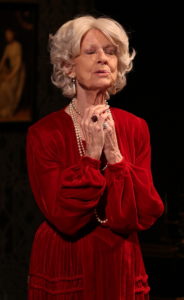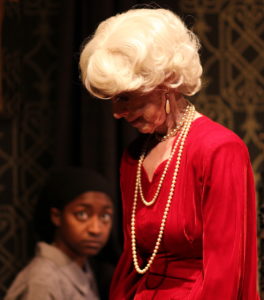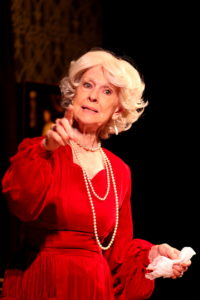Anyone who thinks that storytelling is a lost art should hurry on over to the Quotidian Theatre Company, where Jane Squier Bruns is now holding forth in A Coffin in Egypt, Horton Foote’s masterfully told saga about a 90-year-old woman waiting to die.
Bruns commands the stage for 90 minutes with a brew of bitchery and bile, alternating between girlish vanity and a sense of entitlement as bewildering as it is monstrous.

The play, which was first produced Off-Off-Broadway in 1980, is rarely performed because there are so few actors who can do this sort of thing anymore.
Bruns delivers an incandescent performance as the spoiled Myrtle Bledsoe, the self-centered woman who has outlived all her relatives in a town in Texas called Egypt. (The town is built on the remains of a long-ago plantation, where the ‘Negroes,’ depicted singing in front of a church, always seemed to be happy.)
Myrtle’s tale is told in a single wandering soliloquy that could easily put an audience to sleep. But in the hands and eyes of this actor, the effect is mesmerizing.
Eloquently twisting a small linen handkerchief, eyes blazing with venom and pride, Myrtle revisits her hateful marriage to Hunter and her humiliations at his hands.
Hunter—whom she marries because he is rich (his granddaddy owned the plantation)—is an adulterer with a mulatto mistress. He writes love letters to her, which she reads aloud in a local bar. Another mistress, a white teenager from a common family, sports a big red car. There are two murders and a maniac, running loose around town, known as ‘Little Brother.’

The central image of the play, however, is Myrtle’s long-ago encounter with a great theatrical producer. He tells her she is beautiful, and suggests that she belongs on the stage.
Although the moment is brief and the incident takes place long ago—before the Titanic, we are told—the memory shapes her life.
Horton Foote was an Academy Award, Emmy and Pulitzer Prize-winning playwright and screenwriter. Not surprisingly, this play contains some memorable lines.
One of my favorites is the one where Myrtle explains her feelings about race. “I don’t dislike Negroes,” she says, adding that she dislikes whites even more.
Describing the many admirers met on her travels, she mentions a prince in North Africa. Although he was very handsome, she did not respond to his advances, since, she confides, being African, he might have had “some colored blood.”
Another story involves her husband’s grandfather, the original plantation owner, who liked to boast that while the South may have lost the War, he and his slaves survived. They simply moved from Alabama to Texas, where the slaves became impoverished workers and the cotton grew even bigger.
Many of the stories are repeated, often with new details revealed. But while the language is rich and the repetitions revealing, the play on the whole could benefit from cutting.
Visually, the play is extraordinary. Radiant in a red velvet gown, with ropes of pearls and perfectly coiffed white hair, Myrtle is—as the servant repeatedly assures her—“still beautiful.”

In fact, “you’re still beautiful” are the only words spoken by the servant, who is played with stoic patience, quietly knitting off to the side, by E. Lynda Bruce.
Bruce doubles as stage manager, orchestrating her own comings and goings –mostly carrying a Spode teapot and cups—that delineate night and day.
The set—as often happens at Quotidian—is a perfect replica of a long ago parlor. There are faded carpets, a gas lamp retrofitted for electricity, ebony and gold furniture, and damask curtains framing the single window in which light-filled projections are shown. Don Slater, the Lighting Designer, creates the illusion of night and day as the story unfolds.
Jack Sbarbori is the literal Jack-of-all-Trades at Quotidian, responsible for everything from the fine direction of this play to its set, costumes, and projections. The projections are century-old photographs, mostly found on the Internet, which give shape and form to Myrtle’s memories.
Coffin in Egypt alternates with another dramatic monologue, Conor McPherson’s St Nicholas, starring Steve Beall. (You can read Molly Murchie’s review here.) A third play, Hobson’s Choice—starring DCMTA writer Andrew Walker White—will round out the season for Quotidian’s 20th year.
Running Time: 90 minutes with no intermission.
A Coffin in Egypt plays through December 16, 2017 at Quotidian Theatre Company performing at The Writer’s Center – 4508 Walsh Street, in Bethesda, MD. For tickets, call the box office (301) 816-1023, or purchase them online.




